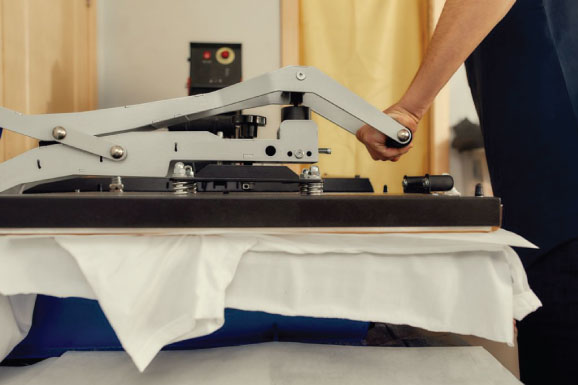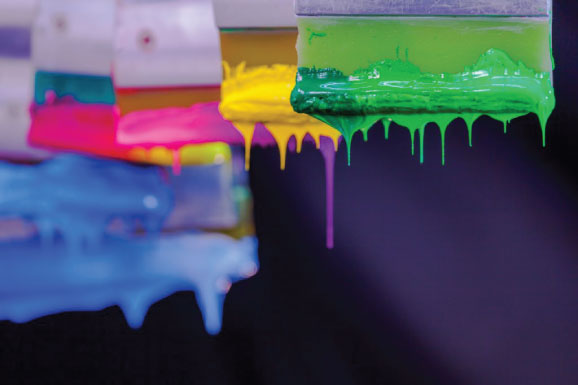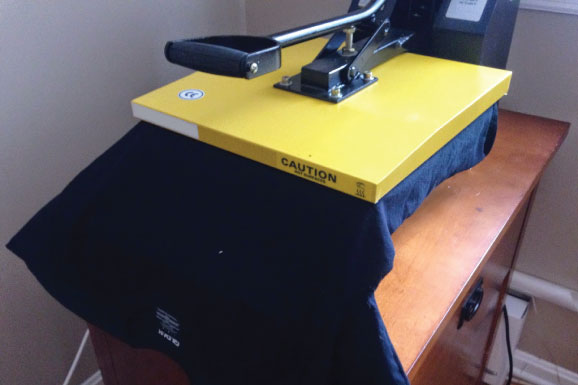
How to Decide Between Heat Transfer Printing & Screen Printing?
T-shirts may be customized in a variety of ways, including screen printing and heat transfer designs. But which design process produces shirts that appear more professional? If you want to make your own personalized t-shirts or start an online shop selling t-shirts, you’ll want to weigh the pros and cons of screen printing vs. heat press transfer.
While heat-transfer designs have greater clarity and appear better right away, screen printing soaks into the fabric and lasts far longer in the long run. A tiny mesh screen transfers layers of ink onto the cloth during screen printing. Heat transfer is a method of adhering to a vinyl graphic on a garment using heat.
You will discover how screen printing and heat press transfers function in this post. You’ll learn what resources you’ll need for each technique. Finally, you’ll learn how to figure out which method is ideal for you!
How does Screen Printing work, and what is it used for?
By spreading thick ink over a mesh screen and then putting it over a stencil, screen printing creates a raised image on the cloth. This forces the ink through the stencil and onto the cloth, resulting in the desired design. This technique is also known as silk screening.
This sort of printing differs from DTG (direct to garment) printing in that it employs a different method. Similar to how a laser printer prints on paper, DTG printing produces various colors straight into the fabric. This approach readily makes intricate and multi-colored images, but unlike screen-printed designs, it does not have a stylish, elevated ink that can last longer.
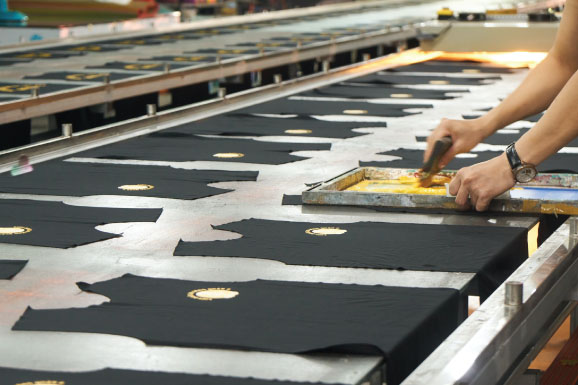
With a few basic arts and crafts items and special Plastisol ink, you can make this style of print at home. To generate multi-colored graphics, professional printing businesses employ enormous machines with several arms, each carrying screens.
A t-shirt with a finalized screen-print pattern has a thick, elevated appearance. Because stacking one stencil on top of another is difficult, these patterns frequently employ only a few colors or even only one color. If you have the correct equipment, you may use screen printing to generate photographs or pictures.
How does Heat Press Transfer work, and what is it?
To generate a raised image on cloth, a heat press transfer employs a substance called heat transfer vinyl, or HTV. Transfer of Heat Vinyl comes in a variety of colors and textures, but it is usually coated on the back with an adhesive. When exposed to heat, this adhesive activates and firmly bonds the vinyl to the cloth.
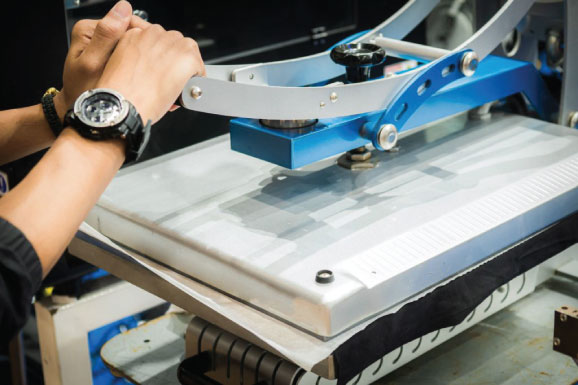
To make vinyl transfer cuts, most artists use computer software like Cricut’s Design Space. The desired shape, such as a lettered logo, a picture, or a witty remark, is then cut out using an electronic cutting machine. After placing the HTV cutout on the garment, the artist uses a heat press to trigger the adhesive on the reverse of the vinyl.
A heat press seals vinyl and fabric between two heated plates, similar to a flat waffle iron or panini press. Small heat presses for home crafters are available, and large commercial heat presses with large heated plates.
When making t-shirt designs out of HTV, many home crafters utilize a Cricut and Cricut’s Easy Press. Silhouette and Brother’s ScanNCut are two more famous brands.
Professional heat transfer methods include multi-colored vinyl placed on a transfer for exact placement on the garment, as well as digital or screen-printed images heat pressed into the cloth.
On a shirt, a completed HTV design has a little raised, somewhat plastic appearance. It has crisp edges and a great appearance, although it generally only uses one color. Layering several vinyl colors can result in unappealing lumps and ridges; however, a skilled artist can use numerous colors side by side to great effect in some circumstances.
What is the difference between screen printing and heat press transfer designs now that you have a rough knowledge of how each design approach works? Is it more difficult to create a heat press design than a screen-printed design, for example? This section will show you how each design technique performs in crucial areas like durability, cost-effectiveness, and quality.
Durability
Which is more durable: screen printing or vinyl? Screen printing outlasts vinyl virtually every time. Vinyl has a respectable lifespan and will last considerably longer than a DTG print, although it will eventually break and fade.
The key difference in terms of longevity between these two types of patterns is that a screen print soaks ink into the fabric, but an HTV design remains on the fabric’s surface, where it is more readily cracked and faded.
Screen printing with properly heat-set plastisol ink should never fracture, peel, or fade after many years of use if done correctly. Some firms claim that a screen print will only last 50 washes in the washer, while others claim that with appropriate care, your screen print will last as long as the shirt fabric!
HTV will ultimately thin, fracture, and fade, although it should last at least a few years before any noticeable damage occurs. The quality of the vinyl used might also affect the heat-transfer design’s endurance. In the washing machine, most decent HTV designs should endure for roughly fifty cycles.
A screen printed or HTV t-shirt should always be washed inside out. This will protect the design from the harsh conditions found inside the washing machine, allowing it to last longer.
Difficulty
Using a heat press to apply an HTV design to a t-shirt is considerably easier than designing a screen print for a t-shirt. Of course, this varies greatly depending on the type of transfer design and the complexity of the print! However, utilizing vinyl is the more convenient choice, and screen printing produces a somewhat higher-quality design.
The majority of this has to do with how much preparation each technique involves.
Heat press designs are simple to put up. Once you have your computer design, transmit it to your electronic cutter and position the vinyl on your garment using transfer paper. Then all you have to do is heat press the pattern for the appropriate period of time.
If you wish to make multiples of the same design, you may reuse your computer design to continue cutting out vinyl forms.
Screen Printing, on the other hand, needs a large number of materials, sophisticated equipment (if you want to work professionally), and a significant amount of time to set up. The trade-off is that once you’ve completed all of the setups, you may print in bulk and continue to use your displays. Screen printing, on the other hand, needs a lot more work than HTV.
Cost-effectiveness
Is it cheaper to print on a heat press or on a screen? In general, screen printing is more cost-effective than heat transfer designs since you can reuse your screens numerous times to produce a larger quantity of shirts for less money.
Basic heat transfer materials, such as vinyl, are substantially less expensive than plastisol ink and other screen-printing chemicals. If you only need one or two shirts, heat transfer designs will save you a lot of money. However, if you want to operate a business and create t-shirts in mass, screen printing becomes much more cost-effective!
Quality
Although not everyone agrees, there is a better case to be made for the superior quality of screen prints over heat transfer patterns. This is partly due to the fact that layering colors in screen printing are easier than in HTV. In addition, screen-printing produces more vibrant colors than heat transfers.
Furthermore, heat transfer graphics look best on light-colored tees. Depending on the color of ink you use, you can effectively screen print on both light and dark clothing.
More elaborate patterns with layered colors are possible using screen printing. It can produce realistic picture images, particularly when working with black and white photos. It features vibrant, bold hues that look well on both light and dark-colored clothes. Single-color HTV designs are attractive, but they lack the depth and vibrancy of a screen print design.
Designs with Multiple Colors and Complexity
Screen printing makes it easier to produce multi-colored or complicated graphics than heat transfer. Instead of utilizing vinyl, you may use a sort of printing and then heat transfer it onto the cloth. For more complicated pictures, you may also employ a heat transferred design in this situation.
The disadvantage of employing this form of heat transfer design is that the ink does not permeate into the cloth-like it would with a screen print. It is less durable and will be ruined easily while washing.
Screen printing with more than one to three inks becomes difficult. However, you can make elaborate stencils on the displays using a process akin to developing pictures, allowing you to overlay colors and create intricate designs.
Speed
In terms of speed, you can make one or two HTV designs in a fraction of the time it takes to set up a screen print. On the other hand, once you’ve completed all of the necessary setups, you can print in bulk utilizing screen printing and produce numerous shirts at once, much faster than you could with the heat transfer approach!
If you’re only making a couple of shirts, HTV will save you a lot of time. If you need a large number of shirts, screen printing will save you time.
Printings Sizes
Screen printing makes printing big orders simple, but each HTV design requires the same amount of effort, making huge orders challenging.
The disadvantage of utilizing vinyl is that each new shirt necessitates cutting off a fresh piece of vinyl. Yes, you can have the digital design ready to use at the touch of a button, but you’ll have to do the trimming, transfer, and heat pressing for each shirt separately.
Once you’ve completed the time-consuming setup, you may print over and over again, producing up to 100 shirts in an hour!
If you have professional equipment, you can fulfill huge orders of 100 or even 1,000 shirts utilizing screen printing. Vinyl heat transfer, on the other hand, works well for orders of less than 100.
Images and Photographs
Screen printing black and white pictures or images is straightforward, although HTV is often used for basic images rather than sophisticated photos. Heat transfer patterns don’t stack well, at least not without forming a big lump on the cloth that feels rigid and unpleasant!
Screen printing may be used to print photographs and images on cloth; however, it works best with black-and-white imagery. To produce detailed screen print stencils on mesh screens, utilize a method similar to how old-school photographers developed negatives. Complex, multi-layered screen print patterns are now possible!
Appropriate for
For cost-effectiveness, most screen printers like to print at least 12 to 24 units at a time, although professional equipment may print up to 200 units in an hour. Smaller orders benefit from heat transfer designs more than larger orders. Making just one or two HTV designs is simple, but producing multiples of the same design takes a lot of time and work.
Printing in volume saves time and money for screen printers; therefore, 500 shirts will frequently cost less per shirt than 100 shirts. Because every heat transfer shirt takes the same amount of time, buying in bulk does not save you money.
Ideal for
Both vinyl heat transfer and screen printing have advantages and disadvantages, as you can see. So, which method will be most effective for you?
Screen Printing is ideal for the following applications:
- You can make photographic designs with one to three colors; however, you may use up to six colors.
- Long-lasting shirts
- Orders in large quantities
- Any cloth or garment of any color
Vinyl Heat Transfer is ideal for the following applications:
- Designs using only one or two colors
- Orders of a small quantity
- Caps and purses, for example, are items that don’t need to be washed as frequently.
- Dark-colored textiles or clothes
Supplies
You’ll need a wide range of equipment to get started, whether you want to screen print at home or establish a vinyl t-shirt business. However, depending on whether you want to manufacture one or two shirts for personal use or hundreds of shirts to sell, the resources you’ll need will vary significantly.
You’ll realize right away that you’ll need a lot more supplies for screen printing than you need for heat transfer designs!
The following are some of the most important materials for Heat Transfer designs:
- A heat press machine is a machine that produces heat. For personal usage, you may purchase a large industrial press or a small four-inch-square press. Heat presses for professional use are available in two styles: clamshell and swing-away. Obviously, the cost varies depending on the type of press you desire.
- A vinyl cutter, to be precise. You may use a small cutter at home, such as a Cricut, or a large cutter that cuts large rolls of vinyl at once.
- Vinyl with a heat transfer (HTV). You’ll need HTV to develop a heat transfer design! *(insert website name)* are good places to look for HTV in tiny quantities. You might wish to buy HTV in quantity online for professional use.
- To print on, you’ll need t-shirts, bags, or caps. You can’t manufacture a product if you don’t have any clothes to print your design.
Screen Printing essentials include:
- A printing press, to be precise. In all honesty, if you’re just screenprinting for fun, you probably don’t need this. If you want to screen print professionally, you may buy anything from a simple one-screen press to complicated machines that layer many screens onto a design.
- A hairdryer that works quickly. To cure the design and make multi-colored designs, you’ll need this. If you want to screen print, instead of buying expensive equipment, you might be able to do so with a heat gun.
- Printing positives to make screens. Depending on the type of screen printing you want to undertake, you may choose a variety of various materials. More complicated gear is required to create superior photo-realistic screen printing.
- Software. You’ll need software to design your prints unless you intend to produce rustic hand-cut stencils for your screens. Anything from Illustrator to specialist screenprinting software is available.
- Screens. Most screens nowadays are made of a polyester mesh, which comes in a variety of mesh counts. The number of threads per square inch is referred to as this. Depending on the sort of print you desire, you’ll require a lower or higher mesh count.
- Ink application tools To apply the stencils, screens, and inks to your press, you’ll need a variety of scrapers and tape.
- Inks and emulsions for screenprinting. In most circumstances, plastisol ink will be used for screen printing. To coat your screen, you’ll need an emulsion, which is a unique chemical.
Which is Better: Vinyl Heat Pressing or Screen Printing?
To determine whether vinyl heat press or screen printing is preferable for your project, you must first determine which approach works best for you.
Screen printing produces the most vibrant colors and graphics that endure the longest. HTV designs last for a long time; however, they aren’t as durable as screen printing. Screen printing allows you to overlay colors and create more complex pictures by employing many screens.
Use a vinyl heat press for basic, low-cost designs or customized orders. With this strategy, there are very few setups or material costs, so you may easily sell modest amounts without making a loss.
Finally, screen printing is ideal for large-scale projects or bulk orders. With this strategy, the more shirts you manufacture, the less they cost!
Hopefully, you now have a better sense of whether you should use a heat press or a screen-printer. Have you ever experimented with a heat press or screen printing? Which approach did you favor out of the two? Please share your opinions below!

